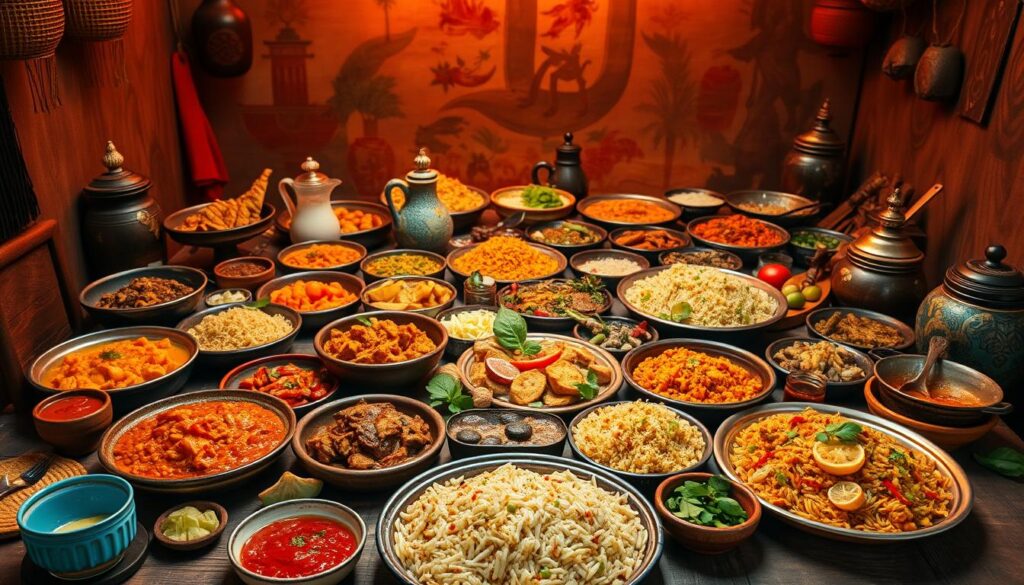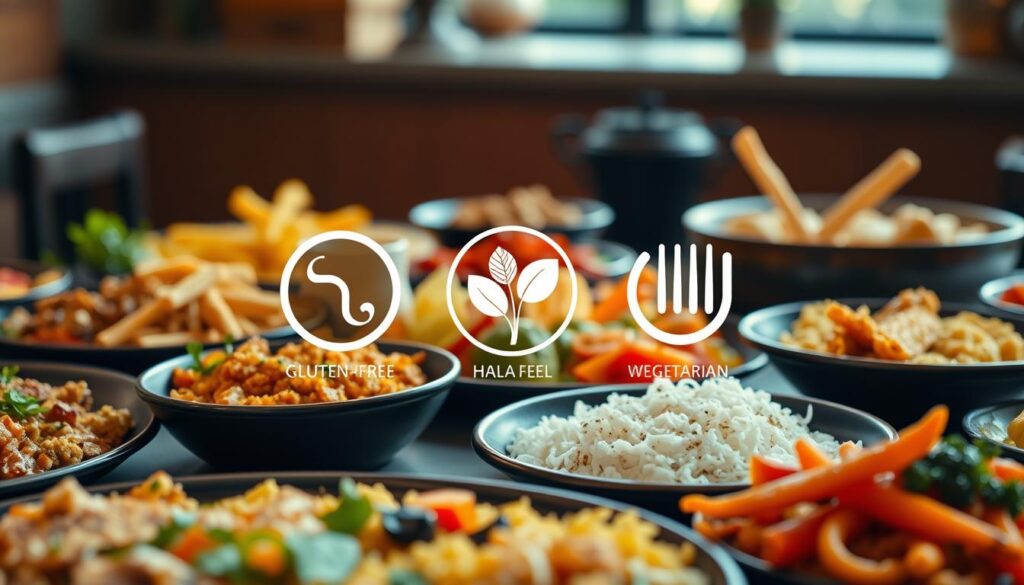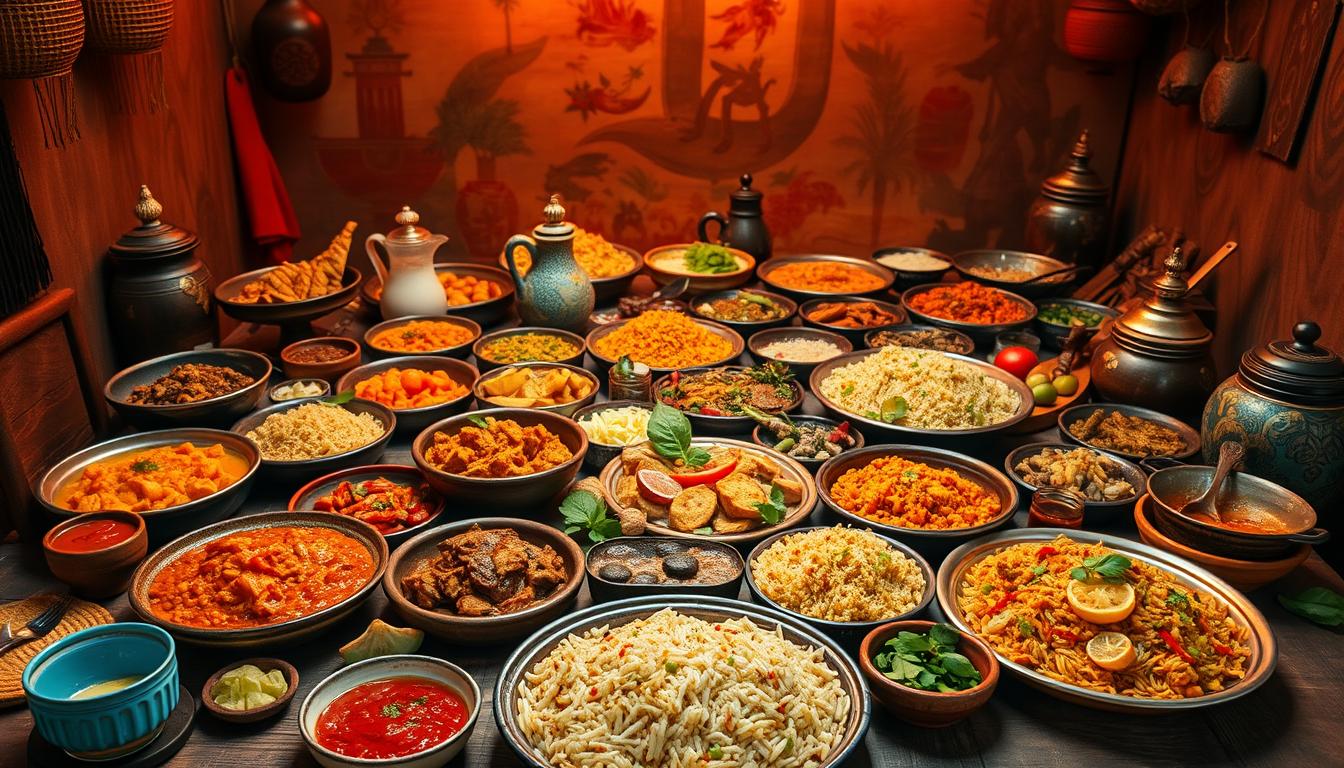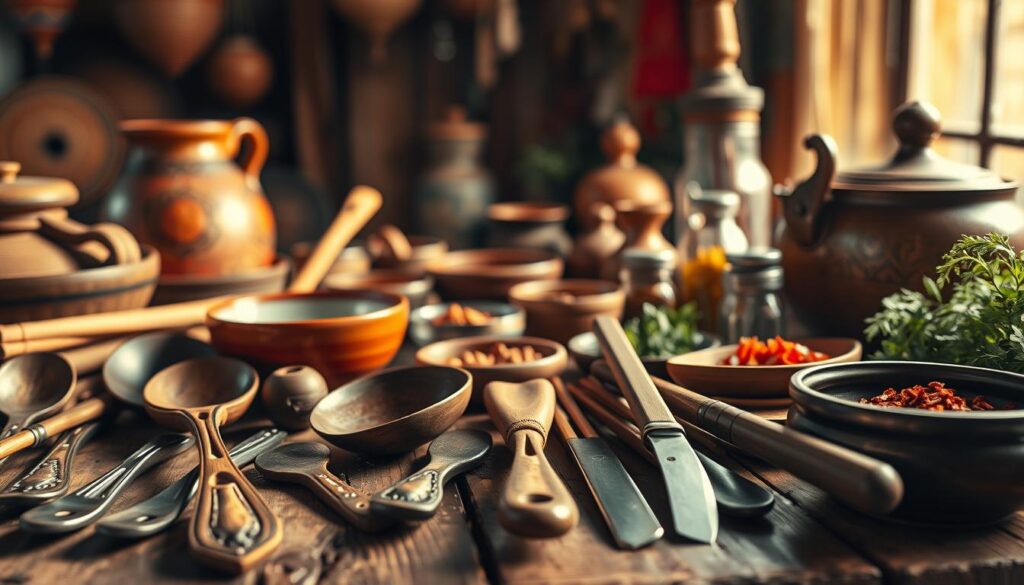Embark on an Ethnic Cuisine Adventure

Are you ready to make your dining experience amazing? What if just one bite could open a world of flavors?
Eating ethnic cuisine is more than trying new dishes. It’s a journey to discover different cultures. Today, 70% of people want to try foods from around the world. And 50% of millennials prefer dishes from other countries.
Exploring international foods is like traveling with your taste buds. You get to experience new flavors and stories. Restaurant owners have seen this trend too, with 60% saying more people want to try dishes from other places.
Discovering new foods is not just about taste. It’s about learning about the traditions and stories behind them. By trying ethnic cuisines, you’re tasting the world, one dish at a time.
Key Takeaways : Ethnic Cuisine
- Ethnic cuisine offers a gateway to cultural understanding
- 70% of diners are eager to explore new culinary experiences
- International dishes provide unique flavor profiles
- Exploring global cuisines broadens personal perspectives
- Authentic ethnic food connects people through shared experiences
Understanding Ethnic Cuisine Exploration
Ethnic cuisine opens a door to the world’s diverse cultures. It invites food lovers to try new flavors and explore global culinary experiences.
Exploring ethnic cuisine is more than just tasting new dishes. It’s a journey that connects us with the culture, history, and traditions behind each recipe.
Defining Ethnic Cuisine
Ethnic cuisine includes traditional cooking and recipes from different cultures. These traditions are known for:
- Unique ingredient combinations
- Specialized cooking techniques
- Cultural significance of preparation methods
- Generational recipe transmission
The Importance of Cultural Diversity
A diverse food journey shows how food goes beyond just eating. It tells stories of migration, adaptation, and cultural exchange. Studies show that food can teach us about different cultures.
How Cuisine Reflects Heritage
Traditional dishes are like living history books. They hold stories, emotions, and identities. For example, mole in Mexican cuisine and kimchee in Korean culture show how food defines community and belonging.
“Food is a fundamental part of culture, contributing to community building and social cohesion.”
By exploring global cooking traditions, we can appreciate cultural diversity and human connections more. These connections go beyond just eating together.
Popular Global Cuisines to Explore
Exploring world cuisine is like going on a journey through different culinary lands. The market for global flavors is expected to hit $23 billion by 2032. This shows how much people want to try traditional dishes from all over.
Every region has its own special tastes that share stories of culture and tradition. These culinary adventures show the rich diversity of global food.
Exploring Asian Flavors
Asian cuisine is a colorful mix of flavors and cooking styles. It ranges from the fine art of Japanese sushi to the strong spices of Indian curries. Each dish offers a unique taste experience.
- Chinese cuisine dominates restaurant scenes in major Asian cities
- Japanese dishes rank second globally on social media
- Korean cuisine continues to gain international popularity
A Journey through European Culinary Traditions
European cuisine is known for its refined take on traditional dishes. Italian cuisine leads the global culinary landscape, with over 20 million Instagram tags. It’s famous for its amazing flavors.
| Cuisine | Instagram Tags | Global Popularity |
|---|---|---|
| Italian | 20+ million | Most Popular |
| French | 15+ million | Highly Recognized |
| Spanish | 10+ million | Growing Trend |
Discovering Latin American Dishes
Latin American cuisine is full of bright flavors and colorful ingredients. Mexican restaurants are big in cities like Los Angeles. They show the area’s big influence on food.
- Mexican cuisine offers diverse regional specialties
- Brazilian barbecue techniques attract global attention
- Peruvian fusion continues to intrigue food enthusiasts
The world of cuisine is a passport to cultural understanding, with each dish telling a unique story of heritage and tradition.
Cooking Techniques from Around the World
Exploring global cooking traditions opens a world of culinary artistry. It’s more than just following recipes. It’s about diving into the heart of cultural cooking methods passed down through generations.
Different parts of the world have unique cooking techniques. These methods turn simple ingredients into amazing dishes. They show off cultural identity and historical practices.
Unique Cooking Methods Across Cultures
Culinary techniques vary a lot:
- Tandoor cooking in Indian cuisine, which uses a clay oven for intense heat
- Wok stir-frying in Chinese cuisine for quick, high-temperature cooking
- Sous-vide in modern French cuisine for precise temperature control
Traditional Cooking Tools and Their Significance
Cultural cooking is tied to special tools. These tools help with flavor and cooking precision:
| Region | Cooking Tool | Culinary Purpose |
|---|---|---|
| Morocco | Tagine | Slow-cooking and spice blending |
| Mexico | Molcajete | Grinding spices and creating pastes |
| Thailand | Mortar and Pestle | Creating complex spice mixtures |
Regional Variations in Cooking Techniques
Cooking methods vary based on local ingredients, climate, and culture. For example, Mediterranean cuisines use olive oil and fresh veggies. Asian techniques often involve quick, high-heat cooking.
“Cooking is about passion, and it can be learned from anyone who loves food.” – Unknown Chef
Learning about these global cooking traditions lets home cooks explore new flavors. It helps us appreciate the rich world of cuisines.
The Role of Spices in Ethnic Cuisines
Spices are the heart and soul of authentic food exploration. They turn simple ingredients into amazing dishes. These aromatic treasures connect us to centuries of cultural traditions and rich flavors.
The global spice market is fascinating. It grows about 5% each year. By 2020, its value will be over $10 billion. Spices are more than just flavor enhancers; they’re cultural ambassadors.
Introduction to Essential Spices
Culinary explorers should know key spices that define global cuisines:
- Cumin: Earthy and warm, popular in Middle Eastern and Indian dishes
- Turmeric: Bright yellow spice with powerful anti-inflammatory properties
- Saffron: Expensive and rare, prized in Mediterranean and Persian cooking
- Cardamom: Fragrant spice used in both sweet and savory preparations
How Spices Enhance Flavor Profiles
Spices are culinary alchemists. They transform simple ingredients into complex taste experiences. They balance flavors, add depth, and create unique sensory journeys that tell stories of regional cooking traditions.
Cultural Significance of Spices
Historically, spices were more valuable than gold, driving global trade and cultural exchanges.
Beyond cooking, spices played crucial roles in medicine, religious practices, and economic interactions. The spice trade connected distant lands, fostering cultural understanding through shared culinary experiences.
Ethnic Food Markets to Visit
Starting a journey of cultural food discovery means visiting vibrant ethnic food markets. These places offer a taste of international cuisine, taking food lovers into the heart of diverse traditions. Each market, whether in a big city or a small neighborhood, has its own story to tell through its ingredients and flavors.
The United States is home to many ethnic markets, showcasing global culinary diversity. Food lovers can find incredible gastronomic experiences at these places.
Top Ethnic Markets in Major U.S. Cities
- Chelsea Market (New York City) – A melting pot of international cuisine
- Grand Central Market (Los Angeles) – Diverse food offerings from multiple cultures
- Pike Place Market (Seattle) – Famous for fresh seafood and local specialties
What to Look for When Shopping
When you’re at ethnic food markets, look for:
- Fresh, authentic produce
- Specialty ingredients unique to specific cuisines
- Traditional cooking tools and utensils
- Pre-prepared local delicacies
Discovering Local Ingredients
Markets give you a chance to find ingredients that big supermarkets don’t have. From rare spices to local produce, these markets are full of surprises for food adventurers.
| Market | Location | Specialty |
|---|---|---|
| San Francisco’s Chinatown | California | Chinese ingredients and produce |
| Mercado Central | Santiago, Chile | Exotic fruits and local produce |
| Borough Market | London, UK | Traditional British and international delicacies |
Exploring these markets lets food lovers enhance their culinary adventures and broaden their cultural food journey.
How to Start Your Own Ethnic Cooking Journey
Starting your ethnic cooking journey is easy. You can do it in your own kitchen. You don’t need to be a pro—just be curious and eager to learn. Many people find their love for international cooking by starting small and learning as they go.
Gathering Essential Equipment
Getting the right tools is key to ethnic cooking. Each cuisine needs special tools to bring out true flavors:
- Wok for Asian stir-frying techniques
- Tagine for North African slow cooking
- Cast-iron skillet for diverse cooking styles
- Mortar and pestle for grinding fresh spices
Finding Authentic Recipes
Finding real recipes is important for exploring ethnic cuisine. Here are some good places to look:
- Ethnic food blogs by expatriates
- Local library international cookbooks
- Cooking classes with cultural focus
- Online culinary communities
Beginner-Friendly Dishes to Try
Start with dishes that are easy and fun. They help you build your cooking confidence:
- Jollof Rice from West Africa
- Butter Chicken from India
- Tacos from Mexico
- Bibimbap from Korea
Cooking ethnic cuisine is all about enjoying the journey. It’s about learning and growing your taste. So, don’t be shy to try new things and make recipes your own!
Understanding Food Pairing in Ethnic Foods
Exploring international culinary experiences shows the art of food pairing. Different cultures mix flavors in unique ways. This turns simple ingredients into amazing meals.
Food pairing is more than just picking ingredients. It’s about creating flavors that work well together. Chefs and home cooks need to know a lot about culture and taste.
Classic Pairings from Various Cultures
Every culture has its own special flavor combinations:
- Japanese cuisine: Sushi paired with sake
- Indian cuisine: Curry with naan bread
- Mexican cuisine: Tacos with fresh salsa
- Mediterranean cuisine: Olives with feta cheese
Balancing Flavors and Textures
Getting flavors to work together is key. Chefs aim to mix:
- Contrasting textures
- Flavors that go well together
- Temperatures that match
| Cuisine | Key Flavor Characteristics | Typical Pairing Strategy |
|---|---|---|
| East Asian | Umami, sweet, sour | Balance through complementary ingredients |
| Mediterranean | Herbal, tangy, rich | Layering subtle flavor notes |
| Latin American | Spicy, bold, complex | Contrasting texture and heat levels |
Regional Beverage Selections
Beverages are key to enhancing traditional dishes. The right drink can make a meal unforgettable.
Pairing food and drink is an art form that reflects centuries of cultural wisdom and culinary innovation.
Navigating Dietary Restrictions in Ethnic Cuisines
Exploring world cuisine means understanding different diets. Many cultures offer great options for those with special dietary needs. This makes trying ethnic foods easier than ever.

Finding food that fits your diet can be tough. But, many ethnic cuisines have tasty alternatives for different diets.
Gluten-Free Ethnic Options
Global cuisines have many gluten-free dishes:
- Asian rice-based dishes
- Mexican corn tortilla cuisine
- Mediterranean vegetable-centered meals
- Indian rice and lentil preparations
Vegetarian and Vegan Choices
Plant-based eating is common in many cultures. This offers lots of vegetarian and vegan options:
- Indian dal and vegetable curries
- Middle Eastern falafel and hummus
- Ethiopian wat with legumes
- Japanese tofu-based dishes
Allergy-Friendly Considerations
Knowing what’s in your food is key for those with allergies. Restaurants and cooks can change recipes to meet dietary needs.
Cultural cuisine adaptation ensures everyone can enjoy delicious meals, regardless of dietary restrictions.
Embracing dietary diversity lets food lovers keep exploring without limits.
The Role of Ethnic Cuisine in Social Gatherings
Food is more than just something we eat. It connects us to our culture and brings people together. When we share meals, we celebrate our traditions and bond with others.
Global cooking traditions show how important food is in social gatherings. Each culture has its own way of using food to connect with others. These moments are unforgettable and go beyond just eating.
Celebrations and Feasts
Ethnic cuisine is key in cultural celebrations around the world. These events highlight the importance of food in social bonding:
- Lunar New Year feast in Chinese communities
- Diwali celebration in Indian households
- Thanksgiving dinner in American families
“Food is our common ground, a universal experience.” – James Beard
The Importance of Sharing Food
Sharing meals is a basic human need. Today, 40% of millennials are non-white, adding to the diversity of food at gatherings. Global cuisine now makes up 24% of all food service occasions.
Unique Eating Customs and Traditions
Every culture has its own eating rituals that show their social ways:
- Chopstick etiquette in East Asian cultures
- Hand-eating traditions in Middle Eastern regions
- Communal dining practices in African communities
These traditions keep our cultural heritage alive. They also help us form strong bonds through shared meals.
Resources for Continued Ethnic Cuisine Exploration
Starting an ethnic-cuisine-exploration journey is exciting. It’s a world full of flavors and new things to learn. You’ll find endless ways to grow your cooking skills.
Finding your way through global cuisines needs good resources and friends. Here are some key tools to help you on your culinary journey.
Recommended Cookbooks and Blogs
Finding real recipes and methods is key. Here are some top picks:
- The Food of India by Priya Krishnaa – A deep dive into Indian cooking
- Serious Eats blog – Wide range of global cooking tips
- Maangchi YouTube channel – Korean cooking lessons
- Global Table Adventure blog – Exploring dishes from everywhere
Culinary Classes to Enhance Skills
Get better at cooking from around the world with classes:
| Platform | Class Type | Focus Area |
|---|---|---|
| Coursera | Online Courses | International Cuisine Techniques |
| Sur La Table | In-Person Workshops | Regional Cooking Classes |
| Udemy | Video Tutorials | Specialized Ethnic Cooking |
Online Communities and Forums
Join others who love exploring ethnic cuisine:
- Reddit r/Cooking subreddit
- Facebook Ethnic Cuisine Groups
- ChefTalk Professional Cooking Forums
- Instagram Food Community Hashtags
“Cooking is about passion, and learning never stops in the culinary world.” – Unknown Chef
Your journey into international cooking is just starting. These resources will help you keep exploring and mastering different cuisines.
Encouragement to Explore and Experiment
Starting an authentic food exploration journey opens up amazing culinary adventures. The United States is full of diverse food experiences. Each dish tells a story, connecting us to cultures around the world.
Home cooking lets us dive into global traditions. Research shows 60% of families who cook international dishes become more curious about world foods. Begin by picking one recipe a month from a different culture to grow your cooking skills.
Local cultural events and food festivals are great for trying real dishes. These events, which are becoming more popular, help students learn more about food. Join neighborhood events, watch cooking demos, and talk to people who share their food stories and traditions.
Exploring food is all about having fun and learning. Be open to new tastes, respect different cultures, and enjoy finding new flavor combinations. Your kitchen can be a place where every meal is a journey into cultural diversity.
FAQ
What exactly is ethnic cuisine exploration?
Ethnic cuisine exploration is a journey through food from around the world. It’s more than just trying new dishes. It’s about understanding the culture, cooking methods, and ingredients. It also looks at how food brings people together.
Why should I be interested in exploring ethnic cuisines?
Exploring ethnic cuisines is exciting. It opens your taste buds to new flavors and cooking styles. You learn about different cultures and grow to appreciate global diversity. It’s a fun way to explore the world through food.
How can I start exploring ethnic cuisines if I’m a beginner?
Start by visiting ethnic restaurants and food markets. Try simple recipes at home and learn new cooking skills. Begin with cuisines that use familiar ingredients. Don’t be afraid to try new things.
Are there dietary-friendly options in ethnic cuisines?
Yes, there are many options for different diets. Asian dishes often have gluten-free rice options. Mediterranean and Indian cooking have plenty of vegetarian and vegan choices. There’s something for everyone.
What equipment do I need to start cooking ethnic cuisines at home?
You’ll need different tools for different cuisines. A wok is great for Asian dishes, while a tagine is perfect for Moroccan cooking. Start with basic tools and add special ones as you try new cuisines.
How important are spices in ethnic cooking?
Spices are key in ethnic cooking. They add unique flavors and reflect cultural traditions. Spices like cumin and turmeric are not just for taste. They also have historical and medicinal value.
Where can I find authentic ingredients for ethnic cooking?
Look for ethnic food markets, international grocery stores, and online retailers. Many cities have markets that offer ingredients not found in regular stores.
How can I learn more about ethnic cuisines beyond cooking?
Join culinary classes and attend food festivals. Participate in online cooking communities and read cookbooks. Follow food blogs and visit cultural centers for workshops and events.
Source Links
- Exploring Ethnic Flavors: Introducing Authentic International Cuisine to Your Menu
- Embark on a Global Gastronomic Adventure: Exploring Vibrant Ethnic Food Neighborhoods Around the World
- 15 Types of Cuisines to Elevate your Taste Buds — Amenify
- How to study ethnic food: senses, power, and intercultural studies – Journal of Ethnic Foods
- Understanding Culture through Food
- Diners Are Craving Bold, Global Flavors And Immersive Food Experiences, Per New Report
- 🍕 TASTE THE WORLD: New Study Reveals the Most Popular Cuisines of 2023 – Oklahoma Farm Report
- Cooking Around The World: Discovering Global Cuisine From Home – MemoryCherish
- Food Culture: 30 UNESCO Culinary Traditions Around the World
- 5 Cookbooks, 5 Cuisines From Around the World
- Consumption of spices and ethnic contamination in the daily diet of Italians – consumers’ preferences and modification of eating habits – Journal of Ethnic Foods
- The Spice Trail: Tracing the Impact of Spices on Global Cuisines – Global Bites
- Ethnic Food Trends in American Restaurants
- 15 Must-Visit Ethnic Food Markets Around the World for a Taste of Culture
- Blogging 101: Exploring Ethnic Cooking
- A Culinary Journey Across the Globe: Exploring Cuisine-Specific Ethnic Foods
- Flavor network and the principles of food pairing – Scientific Reports
- Consider Cultural Food Preferences: FAQ
- Cultural Awareness of Eating Patterns in the Health Care Setting
- The Importance Of Traditional And Ethnic Food | The Momentum
- 4 Ways to Offer Experimental Eating Experiences with Ethnic Cuisine
- The intersection of culture and cuisine: How food shapes our identity – Faculty of Arts
- Food Safety Education for Ethnic Audiences
- Tasty World Tour: Teaching Kids Culture Through Global Cuisines
- Exploring the Flavors of Your Community – KidsGardening


